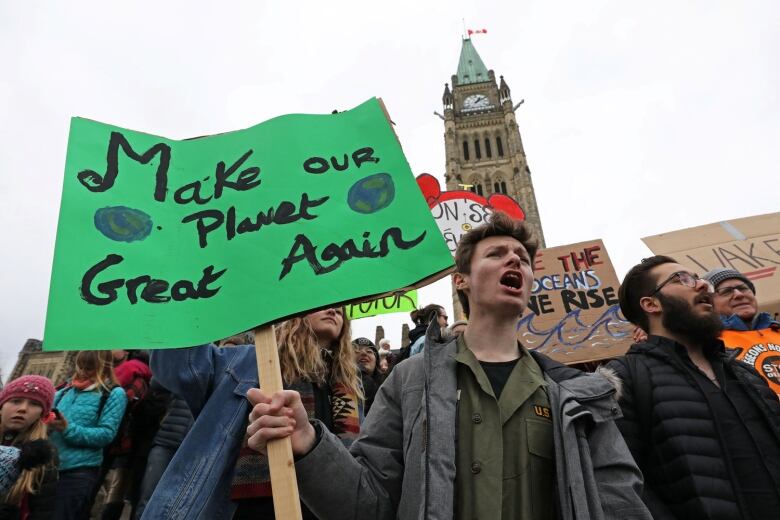A Green New Deal for Canada: What it means
Also: Sustainable jeans are feel-good fashion

Hello, fellow travellers!This is our weekly newsletter on all things environmental, where we highlight trends and solutions that are moving us to a more sustainable world.(Sign up hereto get it in your inbox everyThursday.)
This week:
- What's this about a Canadian Green New Deal?
- The Brits show you can increase GDP while reducing emissions
- Feel-good fashion: The case for sustainable jeans
The Green New Deal travels north

On Monday, people across Canada rallied in support of the environment. It was the first salvo for the Pact for a Green New Deal by a coalition of more than 60 organizations as well as celebrities such as k.d. lang, William Shatner and David Suzuki pushing to make climate action a priority in the upcoming federal election.
Brendan Pietrobon spoke to Concordia University professor Damon Matthews, who was recruited by the Pact to speak to the scientific basis for climate action proposed in the Green New Deal.
What inspired this movement?
One is the U.S. version of the Green New Deal that has been gaining some traction. The other is in Quebec Le pacte pour la transition launched in November of last year. It's a similar idea trying to develop a groundswell of support for social and economic transition in light of the climate challenge. Le pacte has almost 300,000 signatories to date, mostly within the francophone community in Quebec.
What are the goals of the Pact for a Green New Deal?
It's not meant to be a set of policy prescriptions at this point, but more an acknowledgement that we face challenges and that Canada as a country is not providing the kind of climate leadership that we could be. The premise of it is that we need to limit climate change to within a safe regime. Yes, that involves meeting our obligations to the Paris agreement, dramatically strengthening our national emissions targets. In order to be aligned with the Paris agreement, we should be targeting something like a 50 per cent reduction in greenhouse gas emissions by 2030.
What are Canada's unique challenges?
The challenge for us is finding a way to move away from oil and gas as a fundamental part of our economy, while not leaving people behind who are dependent on that industry for their livelihoods.
The starting point, honestly, is a flat-out acknowledgement that the future of oil and gas is limited and we haven't had that conversation at the political level in Canada hardly at all. The conversation right now is still that oil and gas is going to be an important driver of our economy for the next several decades. That narrative fundamentally assumes that we do not take climate mitigation seriously.
What would "doing our part" look like for Canada?
Showing that even though we are a resource-based economy, we can make serious efforts to solve this problem. Obviously, it is a global problem, and Canada's emissions are about 1.5 per cent of global emissions. As a nation, we have a fairly prominent sphere of influence in the world, and if we set an example and show that we're taking this problem seriously, that will give an incentive for others to do the same and ramp up their ambition as well.
What would you like to see happen next?
I hope that people sign on to [the pact]. I hope that the town halls start to provide some tangible ideas and build some momentum. Ultimately, I hope that the federal election that's coming up rallies around climate as a central issue. I think some parties are pushing the climate agenda in important ways; others are not. My hope is that the federal election can be a statement that climate action is actually important to Canadians.
This interview has been edited and condensed.
More on meal kits
Last week, Brendan Pietrobon wrote a piece on a University of Michigan study that found that dinner made from a meal kit had a smaller carbon footprint than one made from grocery items. We felt we should pass on a couple of clarifications for your consideration.
One reader pointed out that in the study, 11 per cent of emissions associated with the grocery-store meals came from using a vehicle to pick up the ingredients. Walking or taking public transportation to the grocery store would bring the two options much closer in terms of carbon emissions and leaving the car at home is always a great choice for the environment.
Also, HelloFresh contacted us to say that the photo accompanying the piece was a little outdated. The company said that packaging is "an important topic for us," and noted that since 2017, HelloFresh has reduced its packaging by about 45 per cent.
Comments? Emailus atwhatonearth@cbc.ca.
The Big Picture: Emissions reductions vs. economic growth
Often, when environmentally minded politicians stress the need to reduce carbon emissions, detractors say that doing so could hurt the economy. That argument is becoming less sustainable, especially if you look at what Great Britain has achieved in the last three decades. Since 1990, the U.K. economy has grown by about 77 per cent all while decreasing emissions by 43 per cent.

Hot and bothered: Provocative ideas from around the web
-
Every week seems to bring another warning of environmental catastrophe. This week, it was a United Nations report stating that a million species of animals and plants are at risk of extinction within decades if we don't take action to restore their habitats.
- One of Canada's most iconic boating experiences is becoming greener. The Maid of the Mist, the fleet of vessels that gives tourists a close-up view of Niagara Falls, is going electric. Thanks to a Swiss company called ABB, two of the boats in the fleet will run on lithium-ion batteries starting in September.
- Canada may be responsible for less than two per cent of worldwide carbon emissions, but that doesn't mean we're blameless. A recent report by the International Energy Agency shows that the vehicles we drive are the biggest, heaviest and least fuel efficient in the world.
- Food waste is a recurring topic in this newsletter. In South Korea, they've found a high-tech way to address the problem: by recycling it. A few years ago, the government introduced a system that compelled consumers to buy special bags and deposit their food scraps in street-level machines. The unused food is subsequently carted off and turned into fertilizer or animal feed. The result: South Koreans now recycle 95 per cent of their food waste.
Blue jeans go green

The phrase has become all too familiar: "We are consuming too much."
But even if your wardrobe is down to the bare essentials, the contents might still be problematic that is, eco-unfriendly.
Most clothing is made from cotton or a blend of synthetic fibres such as plastic-based polyester. Both materials damage the environment, from the heavy use of pesticides associated with growing cotton to the contribution of greenhouse gases from producing synthetics.
Experts say that varying the materials used to make clothes is crucial to reducing the fashion industry's impact on the environment.
"We have to introduce other fibres that aren't so reliant on water, that are freer in their growth so we're not robbing our own resources," said Rachel Miller, studio head of textiles at Sheridan College in Oakville, Ont. She said she is seeing "a higher dependency" on these lower-impact fibres from producers, "because we can't keep going like this."
One of the companies exploring such lower-impact fibres is Canadian-Australian startup ANARA, which makes hemp-based denim. Their jeans are 54 per cent hemp, 44.5 per cent organic cotton and 1.5 per cent spandex.
Co-owner Jamieson McCormack explained that hemp uses less water. A study by the Stockholm Environment Institute shows that one kilogram of cotton enough to make a T-shirt and a pair of jeans uses almost 10,000 litres of water. One kilogram of useful hemp fibre requires 343 litres.
Hemp fabric is also more durable and has antibacterial properties, which means fewer washes, more wears and a longer life for the garment. Miller notes that hemp doesn't need the same amount of chemical processing to turn it into a fibre as other fast-growing plants do, such as bamboo.
ANARA, which sells its wares online, would like to produce their jeans entirely from hemp, but McCormack said that if it wasn't made from a mix of materials, the fabric would lose that classic denim look and feel. She said this is essential, because the goal is to replace what people would normally buy with something that fits the same way but is more eco-friendly and lasts longer.
Despite such efforts, observers say we should only buy for need, not for novelty. Researchers from the Ellen MacArthur Foundation report that clothing production almost doubled between 2000 and 2015.
"If we're still consuming at the same rate, that doesn't solve the problem," said Anika Kozlowski, assistant professor of fashion design ethics and sustainability at Ryerson University. "The best thing you can do is buy something that you're going to own for a really long time and know how to take care of it."
If you are in the market for a new item, there's a tool you can use to investigate your options. The Transparency Index, from advocacy group Fashion Revolution, scores 200 fashion and apparel brands on the transparency of their production methods, including social and environmental impacts.
Christine Rankin
Stay in touch!
Are there issues you'd like us to cover? Questions you want answered? Do you just want to share a kind word? We'd love to hear from you. Email us atwhatonearth@cbc.ca.
Sign up hereto getWhat on Earth?in yourinbox every Thursday.
Editor: Andre Mayer | Logo design: Skdt McNalty












_(720p).jpg)


 OFFICIAL HD MUSIC VIDEO.jpg)
.jpg)



























































































